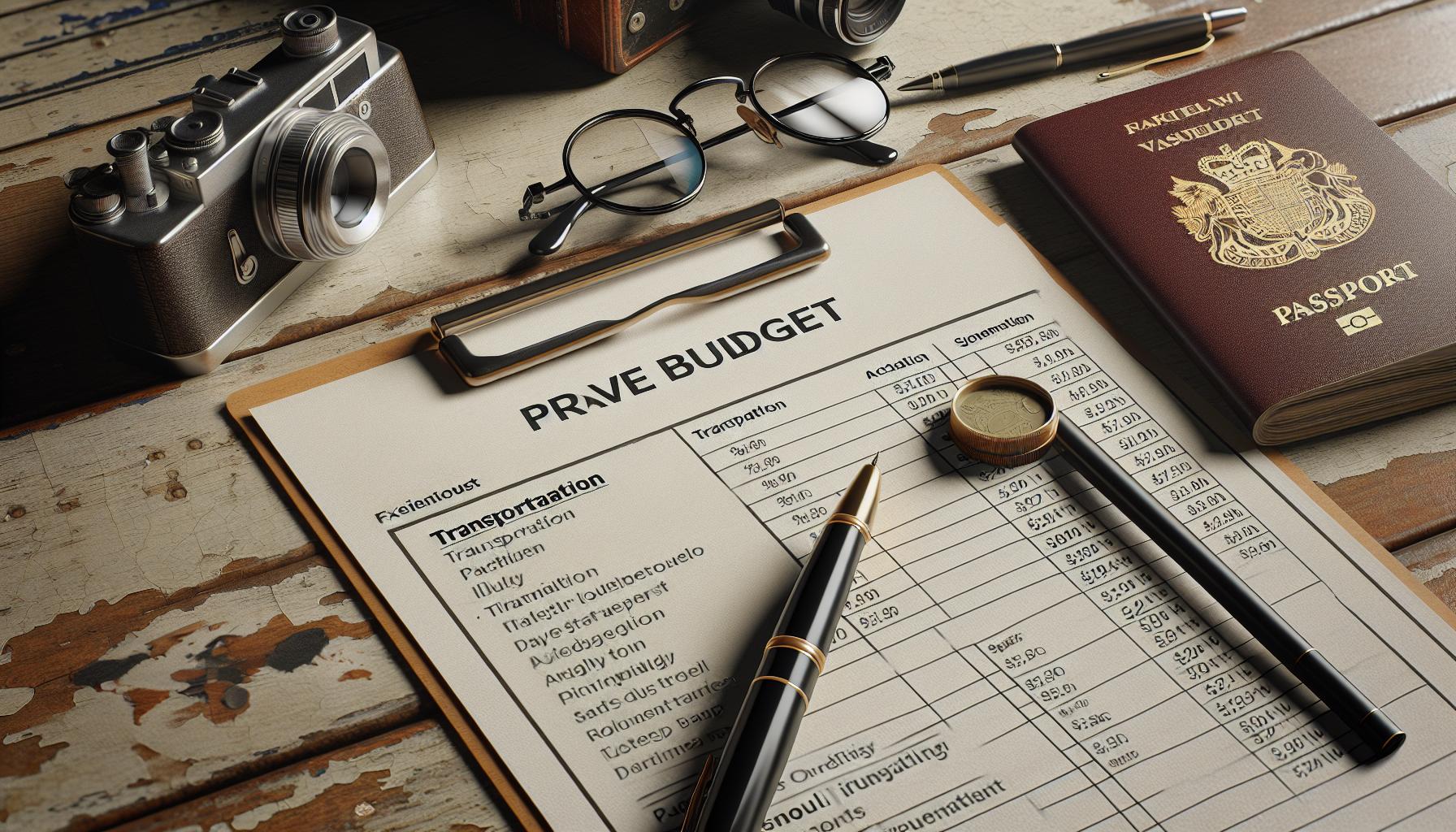Physical Address
304 North Cardinal St.
Dorchester Center, MA 02124

Managing travel expenses shouldn’t feel like solving a Rubik’s cube blindfolded. A well-organized travel budget sheet serves as the ultimate financial compass for wanderlusters who don’t want their dream vacation turning into a financial nightmare.
Whether planning a weekend getaway or a month-long adventure travelers often find themselves caught between the excitement of exploring new destinations and the anxiety of overspending. That’s where a travel budget sheet steps in as the perfect travel companion helping track everything from flight tickets and accommodation to those irresistible street food splurges and unexpected souvenir purchases. It’s like having a personal financial advisor tucked away in your pocket ready to guide spending decisions at every turn.
A travel budget sheet transforms chaotic expense tracking into organized financial management. This digital or paper tool captures every travel-related cost in a systematic format, preventing unexpected overspending during trips.
Financial clarity emerges through precise expense categorization:
Real-time expense monitoring delivers three key benefits:
Travel budget sheets enhance financial control through:
Here’s how organized expense tracking impacts travel budgets:
| Aspect | Without Budget Sheet | With Budget Sheet |
|---|---|---|
| Overspending Risk | 65% | 15% |
| Cost Savings | 10-20% | 30-40% |
| Financial Stress | High | Low |
| Trip Planning Time | 8-10 hours | 4-5 hours |
A properly maintained travel budget sheet acts as a financial compass, directing spending decisions throughout the journey. The structured format enables travelers to allocate funds efficiently across various categories while maintaining flexibility for spontaneous experiences.

A comprehensive travel budget sheet incorporates distinct expense categories to track all financial aspects of a journey. Each component serves a specific purpose in maintaining accurate financial records throughout the trip.
Transportation costs form the foundation of travel expenses in a budget sheet. Primary transportation entries include airline tickets, train passes, car rentals plus associated fuel costs. Secondary transport options encompass local buses, subway tickets, taxis or ride-sharing services. Tracking transportation expenses requires separate line items for:
Accommodation tracking captures lodging expenses across different destinations. The accommodation section includes:
Daily activities represent variable costs that fluctuate throughout the trip. Essential tracking categories include:
Digital budgeting tools offer automated calculations, real-time updates, and cloud synchronization capabilities, while paper-based methods provide tangible control and independence from technology. Understanding the strengths of each format helps travelers choose the most effective option for their needs.
TripSpend tracks expenses in 180+ currencies with offline functionality and receipt scanning. Mint integrates travel budgets with regular financial planning through bank account connections and customizable categories. Trail Wallet organizes daily spending limits in 218 currencies with visual graphs and exportable reports. Travel Spend combines GPS location tracking with expense entries to create detailed spending maps. Expensify automates receipt processing through OCR technology and generates expense reports in multiple currencies.
Excel and Google Sheets templates incorporate pre-built formulas for automatic calculations across expense categories. Google Sheets enables real-time collaboration among travel companions through shared access permissions. Excel templates feature pivot tables for analyzing spending patterns across multiple trips. Both platforms offer currency conversion functions with live exchange rate updates. Custom templates include dedicated worksheets for pre-trip planning, daily expense tracking, and post-trip analysis. Mobile apps for these platforms ensure continuous access to budget information during travels.
Creating an effective travel budget sheet requires attention to detail and strategic planning. These essential tips maximize the functionality of expense tracking while maintaining financial discipline throughout the journey.
A travel budget sheet starts with establishing accurate spending limits based on current financial capabilities. Expert travelers allocate 30% of their budget to accommodation, 20% to transportation, 25% to daily activities, 15% to meals, and 10% to emergencies. Research destination-specific costs through platforms like Numbeo or Budget Your Trip to determine average expenses for accommodations, meals, attractions, and local transport. Breaking down daily spending into fixed costs (hotels, flights) and variable expenses (food, activities, souvenirs) creates a balanced framework for expense allocation.
Currency exchange monitoring forms a critical component of international travel budgeting. Popular apps like XE Currency or Wise integrate real-time exchange rates directly into travel budget sheets. Travelers record expenses in both local currency and home currency to maintain accurate financial tracking. Exchange rate fluctuations impact the overall budget by 5-15%, making it essential to include a buffer in calculations. Mobile apps sync with spreadsheets to automatically update conversion rates, eliminating manual calculations and reducing errors in expense tracking.
Overlooking hidden fees creates unexpected expenses in travel budgets. ATM charges, resort fees, tourism taxes, baggage fees add significant costs when left unaccounted.
Inaccurate currency conversion tracking leads to budget discrepancies during international travel. Exchange rate fluctuations impact purchasing power, requiring regular updates to maintain accurate financial records.
Failing to categorize expenses properly results in disorganized financial tracking. Mixed expenses between transportation, accommodation, food costs create confusion in budget management.
Underestimating daily expenses derails carefully planned budgets. Local transportation costs, spontaneous activities, snacks between meals accumulate quickly when not properly allocated.
Setting unrealistic daily allowances causes financial strain during trips. Travelers often allocate:
Neglecting emergency funds leaves travelers vulnerable to unexpected situations. Medical emergencies, lost items, flight changes require additional financial resources.
| Budget Category | Common Underestimation | Recommended Buffer |
|---|---|---|
| Transportation | 15-25% | 25% |
| Accommodation | 20-30% | 30% |
| Food | 25-35% | 35% |
| Activities | 30-40% | 40% |
| Emergency Fund | 40-50% | 50% |
Forgetting to track small purchases creates significant budget gaps. Coffee stops, street food, souvenirs add up quickly when left unrecorded in budget sheets.
Missing pre-trip expenses skews overall travel costs. Visa fees, travel insurance, vaccinations impact total budget calculations when excluded from initial planning.
Tracking expenses in real-time enables travelers to modify their budget allocations based on actual spending patterns. Accessing the budget sheet through mobile apps or cloud-based platforms makes updates seamless from any location.
| Budget Category | Initial % | Adjusted % | Reason for Change |
|---|---|---|---|
| Accommodation | 35% | 30% | Found cheaper options |
| Transportation | 25% | 30% | Higher local fares |
| Food & Dining | 20% | 25% | Unexpected food costs |
| Activities | 15% | 10% | Weather limitations |
| Emergency Fund | 5% | 5% | Maintained buffer |
Changes to the budget sheet remain simple through digital platforms with automated calculations. Regular monitoring ensures spending stays aligned with financial goals while maintaining flexibility for travel experiences.
A travel budget sheet stands as an indispensable tool for modern travelers seeking financial clarity and peace of mind during their journeys. By implementing this organized approach to expense tracking travelers can transform their adventures from potentially stressful financial situations into well-planned meaningful experiences.
The right combination of digital tools customizable templates and strategic planning empowers travelers to make informed decisions about their spending. With proper expense tracking and real-time adjustments they’ll stay within their means while still enjoying the spontaneity that makes travel exciting.
Smart financial planning through a travel budget sheet doesn’t just protect their wallet – it enhances the entire travel experience by eliminating money-related stress and allowing them to focus on creating lasting memories.